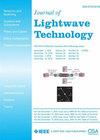On Distributed Polarization-Dependent Loss Monitoring and Mitigation: An Optical Layer Approach Enabled by Pilot Tone Technique
IF 4.1
1区 工程技术
Q2 ENGINEERING, ELECTRICAL & ELECTRONIC
引用次数: 0
Abstract
Polarization-dependent loss (PDL) presents a significant challenge in modern optical fiber networks by causing variations in signal attenuation that depend on the polarization state. This variability degrades the optical signal-to-noise ratio and overall system performance. In most optical links, PDL primarily originates from wavelength selective switches (WSSs), and the variation in signal power occurs because the polarization state of light is not preserved throughout the fiber. Most existing approaches either focus on compensating aggregated PDL through advanced algorithms at the transceiver level or estimating the PDL of each WSS to optimize margin design. In this paper, we introduce a method that integrates distributed PDL monitoring and compensation using low-cost amplitude pilot tone (PT) technology. Our approach involves modulating a polarization-multiplexed signal with two different PT frequencies on each polarization. By measuring the power difference between these polarizations at any PT detection point along the link, we can determine the PDL of devices within the link. Additionally, by placing a polarization controller (PC) between two WSSs, we can adjust the overall PDL by tuning the PC. This enables effective PDL compensation based on our distributed monitoring technique. Extensive experiments have been performed, and the results demonstrate that our method accurately estimates the wavelength-dependent PDL of WSS devices with an accuracy better than分布式偏振相关损耗监测与缓解:导频调音技术实现的光层方法
在现代光纤网络中,极化相关损耗(PDL)会引起依赖于极化状态的信号衰减变化,这是一个重大挑战。这种可变性降低了光信噪比和整体系统性能。在大多数光链路中,PDL主要来自波长选择开关(wss),信号功率的变化是因为光的偏振状态在整个光纤中没有被保留。大多数现有的方法要么集中在通过收发器级的高级算法补偿聚合的PDL,要么估计每个WSS的PDL以优化余量设计。本文介绍了一种利用低成本幅度导频(PT)技术将分布式PDL监测与补偿集成在一起的方法。我们的方法包括在每个偏振上用两个不同的PT频率调制偏振复用信号。通过在链路上任意PT检测点测量这些极化之间的功率差,我们可以确定链路内设备的PDL。此外,通过在两个wss之间放置偏振控制器(PC),我们可以通过调整PC来调整整体PDL。这使得基于我们的分布式监控技术的有效PDL补偿成为可能。大量的实验结果表明,我们的方法可以准确地估计WSS器件的波长相关PDL,精度优于0.1美元dB。此外,在675美元公里的多跨光链路上,它将两个wss的总PDL从大约1.5美元降低到0.3美元。
本文章由计算机程序翻译,如有差异,请以英文原文为准。
求助全文
约1分钟内获得全文
求助全文
来源期刊

Journal of Lightwave Technology
工程技术-工程:电子与电气
CiteScore
9.40
自引率
14.90%
发文量
936
审稿时长
3.9 months
期刊介绍:
The Journal of Lightwave Technology is comprised of original contributions, both regular papers and letters, covering work in all aspects of optical guided-wave science, technology, and engineering. Manuscripts are solicited which report original theoretical and/or experimental results which advance the technological base of guided-wave technology. Tutorial and review papers are by invitation only. Topics of interest include the following: fiber and cable technologies, active and passive guided-wave componentry (light sources, detectors, repeaters, switches, fiber sensors, etc.); integrated optics and optoelectronics; and systems, subsystems, new applications and unique field trials. System oriented manuscripts should be concerned with systems which perform a function not previously available, out-perform previously established systems, or represent enhancements in the state of the art in general.
 求助内容:
求助内容: 应助结果提醒方式:
应助结果提醒方式:


